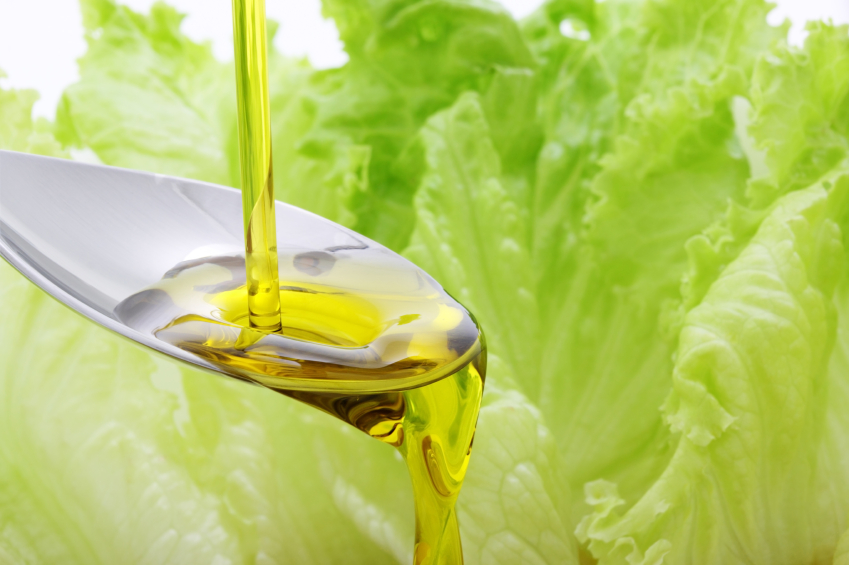Not all oils are created equal, and no single oil should be used for all your cooking needs. Instead, fill your pantry with a variety and learn how to cook with each.
Know the smoke point
Because of their chemical makeup, some oils are better suited for lower-heat cooking than others. This is important because heating oil above its smoke point — the temperature at which the oil begins to smoke — produces toxic fumes and harmful free radicals (the stuff we’re trying to prevent in the first place). A good rule of thumb: the more refined the oil, the higher its smoke point.
High smoke point Best suited for searing, browning and deep frying (avoid).
| Oil | % Mono | % Poly | % Sat | Nutrition Notes |
| Almond | 65 | 28 | 7 | Distinctive nutty flavor |
| Avocado | 65 | 18 | 17 | Sweet aroma |
| Hazelnut | 82 | 11 | 7 | Bold, strong flavor |
| Palm | 38 | 10 | 52 | High in saturated fat. Not recommended |
| Sunflower | 79 | 7 | 14 | Seek out high-oleic versions, which are higher in monounsaturated fat |
| “Light” olive/refined olive | 78 | 8 | 14 | The more refined the olive oil, the better its all-purpose cooking use. “Light” refers to color and is not pure olive oil. |
Medium-high smoke point Best suited for baking, oven cooking or stir frying.
| Oil | % Mono | % Poly | % Sat | Nutrition Notes |
| Canola | 62 | 31 | 7 | Contains low levels of omega-3 |
| Grapeseed | 17 | 73 | 10 | High in omega-6 |
| Macadamia nut | 84 | 3 | 13 | Bold flavor |
| Extra virgin olive | 78 | 8 | 14 | Best-pick oil |
| Peanut | 48 | 34 | 18 | Great for stir frying |
Medium smoke point Best suited for light sautéing, sauces and low-heat baking.
| Oil | % Mono | % Poly | % Sat | Nutrition Notes |
| Corn | 25 | 62 | 13 | High in omega-6. High-oleic (monounsaturated fat) versions coming soon |
| Hemp | 15 | 75 | 10 | Good source of omega-3. Keep refrigerated |
| Pumpkinseed | 32 | 53 | 15 | Contains omega-3 |
| Sesame | 41 | 44 | 15 | Rich, nutty flavor. Keep refrigerated |
| Soybean | 25 | 60 | 15 | High in omega-6 |
| Walnut | 24 | 67 | 9 | Good source of omega-3 |
| Coconut | 6 | 2 | 92 | Lauric acid – fights viruses and bacteria |
No-heat oils* Best used for dressings, dips or marinades.
| Oil | % Mono | % Poly | % Sat | Nutrition Notes |
| Flaxseed | 65 | 28 | 7 | Excellent source of alpha-linolenic acid,
a form of omega-3 |
| Wheat Germ | 65 | 18 | 17 | Rich in omega-6. Keep refrigerated |
*Toasted sesame, extra virgin olive and walnut oils also work well.
Portion control
Choosing the right fat and the right cooking method for that fat are important, but so is proper portion control.
Fats at a glance
Remember the following strategies when it comes to cooking with fats:
Saturated fats – Bottom line: the fewer the better. Less than 7 percent of your daily fat calories should come from saturated fats. Eliminate whole and 2 percent dairy, and limit red meat and other animal protein at meals (reduce frequency, portion size or both).
Trans fats – Eliminate from your diet by avoiding foods that contain hydrogenated or partially hydrogenated oils. (Read the ingredient list!) Shortening and stick margarine contain trans fat.
Monounsaturated fats – Ramp up your intake of olives, avocados and nuts, and use olive and canola oils for most of your cooking and baking, respectively.
Polyunsaturated fats – You’re likely already getting enough omega-6, so focus on increasing your intake of omega-3 foods such as salmon and walnuts.

